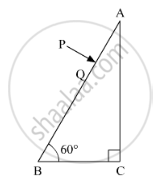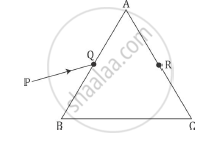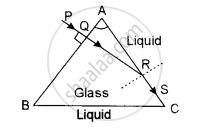Advertisements
Advertisements
प्रश्न
A certain material has refractive indices 1.56, 1.60 and 1.68 rfor red, yellow and violet lightespectively. (a) Calculate the dispersive power. (b) Find the angular dispersion produced by a thin prism of angle 6° made of this material.
उत्तर
Given:-
Refractive index for red light, μr = 1.56
Refractive index for yellow light, μy = 1.60
Refractive index for violet light, μv = 1.68
Angle of prism, A = 6°
(a) Dispersive power \[\left( \omega \right)\] is given by
\[\omega = \frac{\mu_v - u_r}{\mu_y - 1}\]
On substituting the values in the above formula, we get
\[\omega = \frac{\left( 1 . 68 - 1 . 56 \right)}{\left( 1 . 60 - 1 \right)}\]
\[= \frac{0 . 12}{0 . 60} = 0 . 2\]
(b) Angular dispersion = (μv − μr)A
=(0.12) × 6° = 0.72°
Thus, the angular dispersion produced by the thin prism is 0.72°.
APPEARS IN
संबंधित प्रश्न
A ray PQ incident normally on the refracting face BA is refracted in the prism BAC made of material of refractive index 1.5. Complete the path of ray through the prism. From which face will the ray emerge? Justify your answer.

A ray PQ incident on the face AB of a prism ABC, as shown in the figure, emerges from the face AC such that AQ = AR.

Draw the ray diagram showing the passage of the ray through the prism. If the angle of the prism is 60° and refractive index of the material of prism is `sqrt3` , determine the values of angle of incidence and angle of deviation
What is a dispersion of light
Draw the ray diagram showing refraction of light through a glass prism and hence obtain the relation between the refractive index μ of the prism, angle of prism and angle of minimum deviation.
Describe an activity to show that the colours of white light splitted by a glass prism can be recombined to get white light by another identical glass prism. Also, draw a ray diagram to show the recombination of the spectrum of white light.
Out of blue and red light which is deviated more by a prism? Give reason.
Give the formula that can be used to determine refractive index of materials of a prism in minimum deviation condition ?
The equation \[\omega = \frac{\mu_u - \mu_r}{\mu - 1}\] was derived for a prism having small refracting angle. Is it also valid for a prism of large refracting angle? Is it also valid for a glass slab or a glass sphere?
Can the dispersive power \[\omega = \frac{\mu_u - \mu_r}{\mu - 1}\] be negative? What is the sign of ω if a hollow prism is immersed into water?
The angular dispersion produced by a prism ___________ .
A prism can produce a minimum deviation δ in a light beam. If three such prisms are combined, the minimum deviation that can be produced in this beam is _______________.
By properly combining two prisms made of different materials, it is possible to
(a) have dispersion without average deviation
(b) have deviation without dispersion
(c) have both dispersion and average deviation
(d) have neither dispersion nor average deviation
Two prisms of identical geometrical shape are combined with their refracting angles oppositely directed. The materials of the prisms have refractive indices 1.52 and 1.62 for violet light. A violet ray is deviated by 1.0° when passes symmetrically through this combination. What is the angle of the prisms?
The refractive index of a material M1 changes by 0.014 and that of another material M2 changes by 0.024 as the colour of the light is changed from red to violet. Two thin prisms, one made of M1(A = 5.3°) and the other made of M2(A = 3.7°) are combined with their refracting angles oppositely directed. (a) Find the angular dispersion produced by the combination. (b) The prisms are now combined with their refracting angles similarly directed. Find the angular dispersion produced by the combination.
In a regular prism, what is the relation between angle of incidence and angle of emergence when it is in the minimum deviation position?
A narrow beam of monochromatic light, PQ, is incident normally on one face of an equiangular glass prism of refractive index 1.45. When the prism is immersed in a certain liquid, the ray makes a grazing emergence along the other face (See figure). Find the refractive index of this liquid. 
What is meant by the dispersive power of transparent material?
How does the angle of minimum deviation of a glass prism vary if the incident violet light is replaced by red light?
For any prism, obtain a relation between the angle of the prism (A), the angle of minimum deviation (δm) and the refractive index of its material (μ or n).
